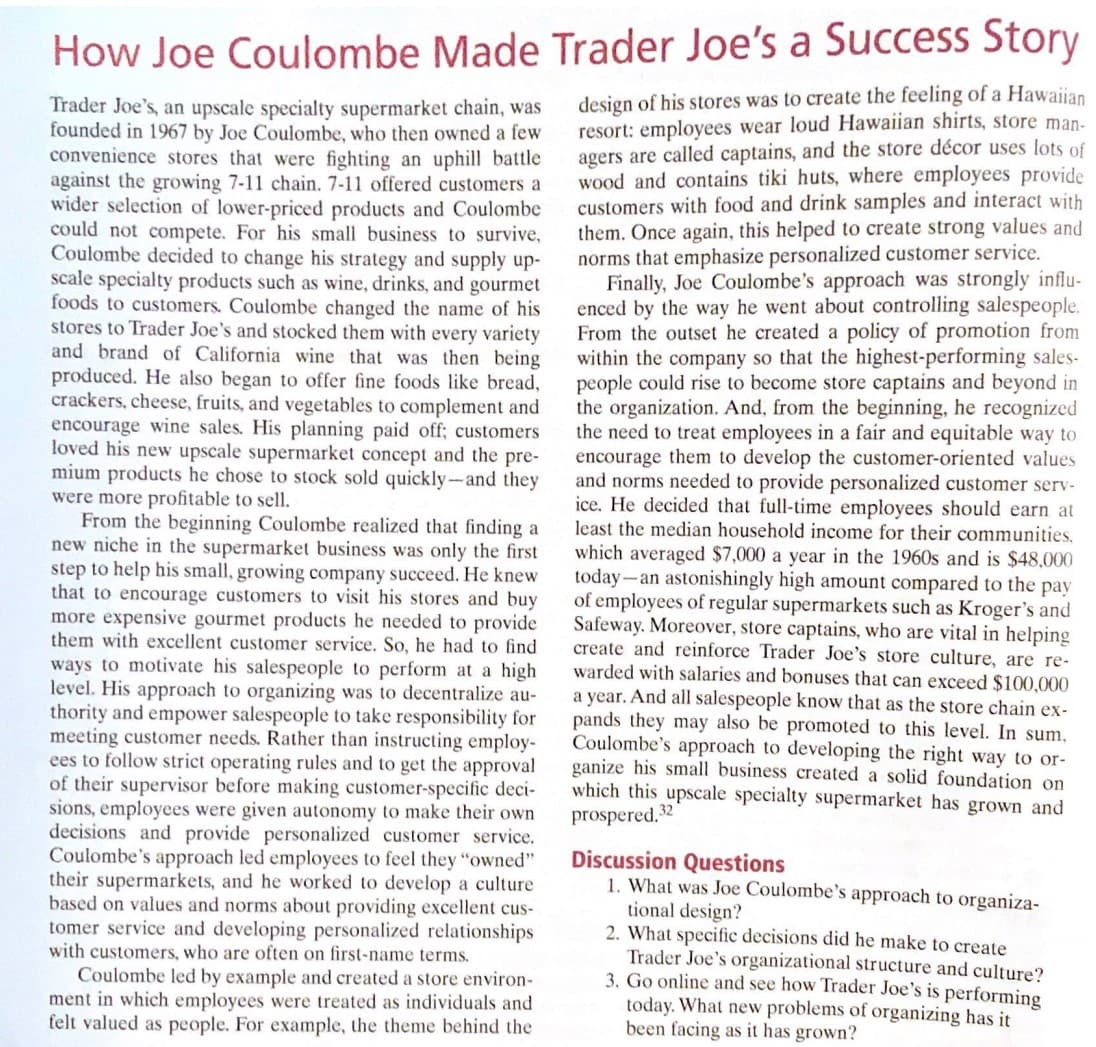1- What was Joe Coulombe's approach to organiza tional design? 2. What specific decisions did he make to create Trader Joe's organizational structure and culture? 3. Go online and see how Trader Joe's is performing today. What new problems of organizing has it been facing as it has grown?
1- What was Joe Coulombe's approach to organiza tional design? 2. What specific decisions did he make to create Trader Joe's organizational structure and culture? 3. Go online and see how Trader Joe's is performing today. What new problems of organizing has it been facing as it has grown?
Chapter2: Planning, Implementing, And Evaluating Marketing Strategies
Section2.1: Inside Tesla’s Strategy For Growth
Problem 1VC
Related questions
Question
1- What was Joe Coulombe's approach to organiza
tional design?
2. What specific decisions did he make to create Trader Joe's organizational structure and culture?
3. Go online and see how Trader Joe's is performing today. What new problems of organizing has it been facing as it has grown?
Could you explain bit more?

Transcribed Image Text:How Joe Coulombe Made Trader Joe's a Success Story
design of his stores was to create the feeling of a Hawaiian
resort: employees wear loud Hawaiian shirts, store man-
agers are called captains, and the store décor uses lots of
wood and contains tiki huts, where employees provide
customers with food and drink samples and interact with
them. Once again, this helped to create strong values and
norms that emphasize personalized customer service.
Finally, Joe Coulombe's approach was strongly influ-
enced by the way he went about controlling salespeople.
From the outset he created a policy of promotion from
within the company so that the highest-performing sales-
people could rise to become store captains and beyond in
the organization. And, from the beginning, he recognized
the need to treat employees in a fair and equitable way to
encourage them to develop the customer-oriented values
and norms needed to provide personalized customer serv-
ice. He decided that full-time employees should earn at
least the median household income for their communities.
Trader Joe's, an upscale specialty supermarket chain, was
founded in 1967 by Joe Coulombe, who then owned a few
convenience stores that were fighting an uphill battle
against the growing 7-11 chain. 7-11 offered customers a
wider selection of lower-priced products and Coulombe
could not compete. For his small business to survive,
Coulombe decided to change his strategy and supply up-
scale specialty products such as wine, drinks, and gourmet
foods to customers. Coulombe changed the name of his
stores to Trader Joe's and stocked them with every variety
and brand of California wine that was then being
produced. He also began to offer fine foods like bread,
crackers, cheese, fruits, and vegetables to complement and
encourage wine sales. His planning paid off; customers
loved his new upscale supermarket concept and the pre-
mium products he chose to stock sold quickly-and they
were more profitable to sell.
From the beginning Coulombe realized that finding a
new niche in the supermarket business was only the first
step to help his small, growing company succeed. He knew
that to encourage customers to visit his stores and buy
more expensive gourmet products he needed to provide
them with excellent customer service. So, he had to find
ways to motivate his salespeople to perform at a high
level. His approach to organizing was to decentralize au-
thority and empower salespeople to take responsibility for
meeting customer needs. Rather than instructing employ-
ees to follow strict operating rules and to get the approval
of their supervisor before making customer-specific deci-
sions, employees were given autonomy to make their own
decisions and provide personalized customer service.
Coulombe's approach led employees to feel they "owned"
their supermarkets, and he worked to develop a culture
based on values and norms about providing excellent cus-
tomer service and developing personalized relationships
with customers, who are often on first-name terms.
Coulombe led by example and created a store environ-
ment in which employees were treated as individuals and
felt valued as people. For example, the theme behind the
which averaged $7,000 a year in the 1960s and is $48,000
today-an astonishingly high amount compared to the pay
of employees of regular supermarkets such as Kroger's and
Safeway. Moreover, store captains, who are vital in helping
create and reinforce Trader Joe's store culture, are re-
warded with salaries and bonuses that can exceed $100,000
a year. And all salespeople know that as the store chain ex-
pands they may also be promoted to this level. In sum,
Coulombe's approach to developing the right way to or-
ganize his small business created a solid foundation on
which this upscale specialty supermarket has grown and
prospered. 32
Discussion Questions
1. What was Joe Coulombe's approach to organiza-
tional design?
2. What specific decisions did he make to create
Trader Joe's organizational structure and culture?
3. Go online and see how Trader Joe's is performing
today. What new problems of organizing has it
been facing as it has grown?
Expert Solution
This question has been solved!
Explore an expertly crafted, step-by-step solution for a thorough understanding of key concepts.
This is a popular solution!
Trending now
This is a popular solution!
Step by step
Solved in 2 steps

Knowledge Booster
Learn more about
Need a deep-dive on the concept behind this application? Look no further. Learn more about this topic, management and related others by exploring similar questions and additional content below.